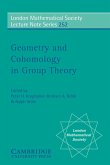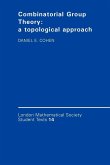- Broschiertes Buch
- Merkliste
- Auf die Merkliste
- Bewerten Bewerten
- Teilen
- Produkt teilen
- Produkterinnerung
- Produkterinnerung
Originally published in 1983, the principal object of this book is to discuss in detail the structure of finite group rings.
Andere Kunden interessierten sich auch für
![Homological Group Theory Homological Group Theory]() C. T. C. WallHomological Group Theory64,99 €
C. T. C. WallHomological Group Theory64,99 €![Topics in Varieties of Group Representations Topics in Varieties of Group Representations]() Samuel M. VovsiTopics in Varieties of Group Representations46,99 €
Samuel M. VovsiTopics in Varieties of Group Representations46,99 €![The Atlas of Finite Groups - Ten Years on The Atlas of Finite Groups - Ten Years on]() R. T. Curtis / R. A. Wilson (eds.)The Atlas of Finite Groups - Ten Years on74,99 €
R. T. Curtis / R. A. Wilson (eds.)The Atlas of Finite Groups - Ten Years on74,99 €![Geometry and Cohomology in Group Theory Geometry and Cohomology in Group Theory]() H. Kropholler / A. Niblo / Ralph Stöhr (eds.)Geometry and Cohomology in Group Theory90,99 €
H. Kropholler / A. Niblo / Ralph Stöhr (eds.)Geometry and Cohomology in Group Theory90,99 €![Combinatorial Group Theory Combinatorial Group Theory]() Daniel E. CohenCombinatorial Group Theory68,99 €
Daniel E. CohenCombinatorial Group Theory68,99 €![The Subgroup Structure of the Finite Classical Groups The Subgroup Structure of the Finite Classical Groups]() Peter KleidmanThe Subgroup Structure of the Finite Classical Groups96,99 €
Peter KleidmanThe Subgroup Structure of the Finite Classical Groups96,99 €![Introduction to Group Characters Introduction to Group Characters]() Walter LedermannIntroduction to Group Characters46,99 €
Walter LedermannIntroduction to Group Characters46,99 €-
-
-
Originally published in 1983, the principal object of this book is to discuss in detail the structure of finite group rings.
Produktdetails
- Produktdetails
- Verlag: Cambridge University Press
- Seitenzahl: 286
- Erscheinungstermin: 26. April 2011
- Englisch
- Abmessung: 229mm x 152mm x 17mm
- Gewicht: 468g
- ISBN-13: 9780521274876
- ISBN-10: 0521274877
- Artikelnr.: 26731268
- Herstellerkennzeichnung
- Libri GmbH
- Europaallee 1
- 36244 Bad Hersfeld
- gpsr@libri.de
- Verlag: Cambridge University Press
- Seitenzahl: 286
- Erscheinungstermin: 26. April 2011
- Englisch
- Abmessung: 229mm x 152mm x 17mm
- Gewicht: 468g
- ISBN-13: 9780521274876
- ISBN-10: 0521274877
- Artikelnr.: 26731268
- Herstellerkennzeichnung
- Libri GmbH
- Europaallee 1
- 36244 Bad Hersfeld
- gpsr@libri.de
Preface
Part I. The Structure of Group Algebras: 1. Idempotents in rings. Liftings
2. Projective and injective modules
3. The radical and artinian rings
4. Cartan invariants and blocks
5. Finite dimensional algebras
6. Duality
7. Symmetry
8. Loewy series and socle series
9. The p. i. m.'s
10. Ext
11. Orders
12. Modular systems and blocks
13. Centers
14. R-forms and liftable modules
15. Decomposition numbers and Brauer characters
16. Basic algebras and small blocks
17. Pure submodules
18. Examples
Part II. Indecomposable Modules and Relative Projectivity: 1. The trace map and the Nakayama relations
2. Relative projectivity
3. Vertices and sources
4. Green Correspondence
5. Relative projective homomorphisms
6. Tensor products
7. The Green ring
8. Endomorphism rings
9. Almost split sequences
10. Inner products on the Green ring
11. Induction from normal subgroups
12. Permutation models
13. Examples
Part III. Block Theory: 1. Blocks, defect groups and the Brauer map
2. Brauer's First Main Theorem
3. Blocks of groups with a normal subgroup
4. The Extended First main Theorem
5. Defect groups and vertices
6. Generalized decomposition numbers
7. Subpairs
8. Characters in blocks
9. Vertices of simple modules
10. Defect groups
Appendices
References
Index.
Part I. The Structure of Group Algebras: 1. Idempotents in rings. Liftings
2. Projective and injective modules
3. The radical and artinian rings
4. Cartan invariants and blocks
5. Finite dimensional algebras
6. Duality
7. Symmetry
8. Loewy series and socle series
9. The p. i. m.'s
10. Ext
11. Orders
12. Modular systems and blocks
13. Centers
14. R-forms and liftable modules
15. Decomposition numbers and Brauer characters
16. Basic algebras and small blocks
17. Pure submodules
18. Examples
Part II. Indecomposable Modules and Relative Projectivity: 1. The trace map and the Nakayama relations
2. Relative projectivity
3. Vertices and sources
4. Green Correspondence
5. Relative projective homomorphisms
6. Tensor products
7. The Green ring
8. Endomorphism rings
9. Almost split sequences
10. Inner products on the Green ring
11. Induction from normal subgroups
12. Permutation models
13. Examples
Part III. Block Theory: 1. Blocks, defect groups and the Brauer map
2. Brauer's First Main Theorem
3. Blocks of groups with a normal subgroup
4. The Extended First main Theorem
5. Defect groups and vertices
6. Generalized decomposition numbers
7. Subpairs
8. Characters in blocks
9. Vertices of simple modules
10. Defect groups
Appendices
References
Index.
Preface
Part I. The Structure of Group Algebras: 1. Idempotents in rings. Liftings
2. Projective and injective modules
3. The radical and artinian rings
4. Cartan invariants and blocks
5. Finite dimensional algebras
6. Duality
7. Symmetry
8. Loewy series and socle series
9. The p. i. m.'s
10. Ext
11. Orders
12. Modular systems and blocks
13. Centers
14. R-forms and liftable modules
15. Decomposition numbers and Brauer characters
16. Basic algebras and small blocks
17. Pure submodules
18. Examples
Part II. Indecomposable Modules and Relative Projectivity: 1. The trace map and the Nakayama relations
2. Relative projectivity
3. Vertices and sources
4. Green Correspondence
5. Relative projective homomorphisms
6. Tensor products
7. The Green ring
8. Endomorphism rings
9. Almost split sequences
10. Inner products on the Green ring
11. Induction from normal subgroups
12. Permutation models
13. Examples
Part III. Block Theory: 1. Blocks, defect groups and the Brauer map
2. Brauer's First Main Theorem
3. Blocks of groups with a normal subgroup
4. The Extended First main Theorem
5. Defect groups and vertices
6. Generalized decomposition numbers
7. Subpairs
8. Characters in blocks
9. Vertices of simple modules
10. Defect groups
Appendices
References
Index.
Part I. The Structure of Group Algebras: 1. Idempotents in rings. Liftings
2. Projective and injective modules
3. The radical and artinian rings
4. Cartan invariants and blocks
5. Finite dimensional algebras
6. Duality
7. Symmetry
8. Loewy series and socle series
9. The p. i. m.'s
10. Ext
11. Orders
12. Modular systems and blocks
13. Centers
14. R-forms and liftable modules
15. Decomposition numbers and Brauer characters
16. Basic algebras and small blocks
17. Pure submodules
18. Examples
Part II. Indecomposable Modules and Relative Projectivity: 1. The trace map and the Nakayama relations
2. Relative projectivity
3. Vertices and sources
4. Green Correspondence
5. Relative projective homomorphisms
6. Tensor products
7. The Green ring
8. Endomorphism rings
9. Almost split sequences
10. Inner products on the Green ring
11. Induction from normal subgroups
12. Permutation models
13. Examples
Part III. Block Theory: 1. Blocks, defect groups and the Brauer map
2. Brauer's First Main Theorem
3. Blocks of groups with a normal subgroup
4. The Extended First main Theorem
5. Defect groups and vertices
6. Generalized decomposition numbers
7. Subpairs
8. Characters in blocks
9. Vertices of simple modules
10. Defect groups
Appendices
References
Index.









